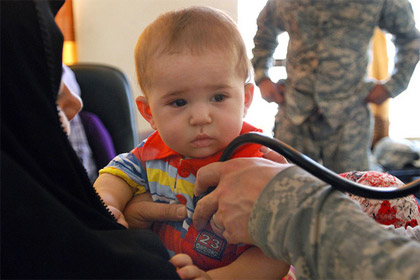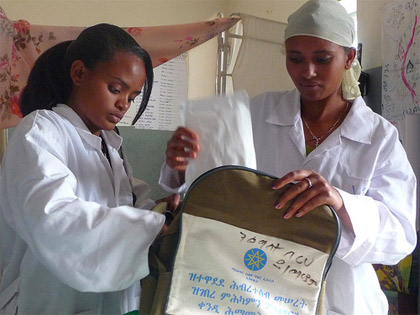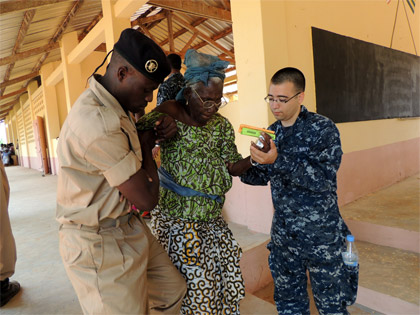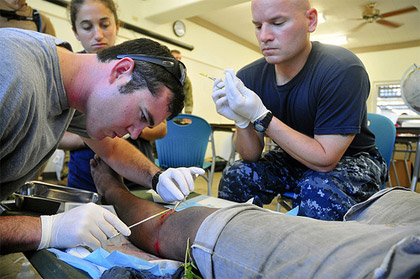Disaster & Humanitarian Assistance Medicine
The Center for Disaster and Humanitarian Assistance Medicine (CDHAM) is part of the Uniformed Services University of the Health Sciences (USUHS) within the Department of Military and Emergency Medicine (MEM). USUHS is a center of excellence for military and public health education and research, and it is dedicated to innovative research in military medicine and nursing as well as public health. Events throughout the past two decades have made it clear that security at home cannot exist without global stability. CDHAM contributes directly to national security by means of healthcare and public health assistance, which results in “wise diplomacy” or “smart power.” This, then, enables host nation governments to stabilize regions with the ultimate goal of subsequent global stability. Healthcare is a bridge permitting non-threatening interactions between parties that otherwise would not likely communicate. In this capacity, healthcare is a diplomatic tool, which builds relationships that allow access and influence in a positive manner.
CDHAM provides support to multiple Department of Defense (DoD) initiatives through healthcare and public health consultation, education and training, scholarly activities and direct service (also known in the military by the acronym “Boots on the Ground” or “BOG”). CDHAM is uniquely structured to access and to deploy subject matter experts in numerous relevant areas for DoD response to healthcare crises – from emergency disaster response to worldwide partner nation infrastructure development.
Collaborative organizational partners that have worked with CDHAM include all Combatant Commands (COCOMS), Armed Forces Health Surveillance Center (AFHSC) and International Health Division of the Office of the Assistant Secretary of Defense for Health Affairs (OASD/HA). Interagency partners across the federal government include the Department of State (DoS), U.S. Agency for International Development (USAID), Department of Health and Human Services (DHHS) and Department of Homeland Security (DHS).
CDHAM’s various programs include the following:
- Avian Influenza/Pandemic Influenza (AI/PI) Program,
- Defense Medical Language Initiative (DMLI) Health Language and Culture Curricula,
- Cooperative Biological Engagement Program (CBEP) for the Defense Threat Reduction Agency (DTRA),
- U.S. Africa Command Disaster Planning and Preparedness Program (DP3),
- Medical Stability Operations Curriculum Development Program (MSOC) and
- U.S. Africa Command Pandemic Response Program (PRP).
The Avian Influenza/Pandemic Influenza (AI/PI) Program provides assistance and support to the geographic COCOMs to create, develop and support unified pandemic influenza response planning and to produce functional pandemic influenza response plans for host nations and COCOMs. This program has been engaged worldwide and plays a vital role in preparing underserved nations worldwide, especially Latin America, Africa and Asia, for the eventuality of a severe influenza epidemic or pandemic.

U.S. Army photo by Sgt. 1st Class Joe Thompson | U.S. Army Capt. Jason Smith listens to an infant’s breathing at the last “Bring on the Docs” cooperative medical engagement at Jassan Health Clinic in Wasit province, Iraq, June 23, 2009.
The Defense Medical Language Initiative (DMLI) Health Language and Culture Curricula is designed to provide U.S. military health personnel with the knowledge and skills required to engage indigenous people and healthcare systems. Curricula specifically address the unique health language and culture of the individual location to include health provider-patient interactions. The resulting course of study is deliberately structured to allow relevant modification as appropriate for delivery for the specific host nation or audience. Curricula currently in development and/or validation as pilot programs by DMLI include Afghan (Pashto and Dari languages), Iraq (Arabic) and the Arabic Region (Modern Standard Arabic). The final DMLI product is intended to be a generic health language and culture curriculum, which could be adapted to any location as needed. Curricula are structured to inform health engagement at three levels: strategic (stewardship), operational (creating health resources) and tactical (health service delivery).
The strategic (stewardship) portion of DMLI curricula addresses elements of general health information applicable to health system design and development. This is most germane to the managerial function of healthcare agencies within a specific country or area. Current content includes determinants of health, health system structure to include health policy and financing issues, and health resources. In addition, regional information is presented to provide participants an understanding of the country’s health within the specific local area context. General health information elements are complemented by health culture and health language terminology that are appropriate for use at the strategic level.
The operational criteria (creating health resources) element of DMLI curricula addresses components of the health system that create resources to provide for the healthcare of the country – specifically related to various forms of medical training for healthcare professionals. Current course content of these particular instructional modules includes the structure of the health education and training system to encompass inherent government and societal infrastructure and resources that support the system. Information is complemented by health culture and health language terminology appropriate for use at the operational level.
The DMLI tactical (delivering health services) curricula component addresses the process and forms of healthcare delivery to local populations. Course content includes information on the general health of the population, health facilities, human resources, access to healthcare services and health needs of the population. This information is complemented by indigenous health culture and health language terminology as appropriate for use at the tactical level.
The structure and content of the DMLI Health Language and Culture Curricula allows for adjustment and modification (in advance or on site) to best fit the needs and availability of the student population.
DMLI curricula instructional framework consists of the following:
- Warm-up – Prepares students for an optimal learning environment via brainstorming and other interactive activities;
- Didactic Lectures – Presents information required for the most highly effective follow-on health engagements;
- Exercise – Includes a variety of on-site activities to reinforce and build on information presented during the didactic lecture. This includes role playing, case studies and discussion;
- Assessment – Assesses student competency and retention of course material and designs methods for the best future use of course materials by students (i.e., “train-the-trainer” methodology).

Photo by Kelly Ramundo, USAID | Health extension workers at the Endamarian Health Post outside Enticho in Tigray pack up their kits and health education materials in prepration for the long walk to the villages they support.
DMLI Health Language and Culture Curricula are developed based upon evidence extracted from research. This investigation includes surveys of U.S. and partner nation personnel, published literature and interaction with a community of subject matter experts. Additionally, personal experiences and personal and professional contacts of DMLI team members complement the core health information. Curriculum content is then built around a framework of public health and health system design principals as supported by the World Health Organization (WHO), the health system development community and international schools of medicine and public health. Once developed, curricula are submitted to an active and on-going review, validation and testing process to gain feedback and counsel from a community of participating practitioners in the health, language and culture communities.
The Cooperative Biological Engagement Program (CBEP) for the Defense Threat Reduction Agency (DTRA). CBEP’s objectives are to cooperatively assist partner nation governments to address obligations they have assumed by signing the United Nations National Security Council Resolution 1540. Additional objectives are to prevent proliferation of nuclear, chemical and biological weapons and their means of delivery, including by establishing appropriate controls over related materials as well as WHO’s International Health Regulations (IHR), which enhance national, regional and global public health security.
Specifically focusing on the biological agents, CBEP provides education and training to enhance clinical, laboratory and epidemiological safety and security with regard to especially dangerous pathogens. CBEP also works to strengthen partner nations’ detection, diagnostic and reporting systems as well as to fund and to conduct academic and scientific research on especially dangerous pathogens. The latter include most all pathogens universally recognized to be quite harmful to humans and animals, including those on the Centers for Disease Control and Prevention (CDC) bioterrorism agents and disease lists, which encompasses Categories A, B and C. CBEP works with the DoS, USAID, CDC and COCOMS to ensure a fully coordinated program designed to provide maximum support to the partner nation.
CDHAM has developed a Requirements Validation Process (RVP) to identify capacities and capabilities of core biological functions within the policy and legal frameworks and health systems of a partner country. These essential capacities include important public health measures, such as disease surveillance and detection, laboratory and clinical diagnosis, pathogen detection, diagnosis, reporting, monitoring and control, and biological safety (biosafety) and biological security (biosecurity). Upon completion, RVP is anticipated to provide a baseline assessment that should enable both CBEP and the partner country to identify a mutually agreeable course of action to strengthen and augment the partner nation’s ability to meet its obligations under UN 1540 and WHO IHRs.

Photo By Kristopher Radder | Hospitalman Justin Garcia and a member of the Togolese military help a woman down the steps during a health fair as part of Africa Partnership Station (APS), September 18, 2012.
The U.S. Africa Command Disaster Planning and Preparedness Program (DP3) is designed to enhance capacity of African nations to prepare for, respond to and mitigate disasters, and to develop sustainable long-term relationships on the continent that will enhance African capacity to support and respond regionally.
In support of this effort, assessments of African national emergency management programs for various nations are needed to form baselines of response capacity, to support development of national work plans and to evaluate the impact of DP3 in the future. Reliable measurement parameters for DP3 are also needed to support long-term efforts and to determine program efficacy. The DP3 goal is to help develop African partner nations with a strengthened capacity to respond to a disaster and to promote their ability to mitigate threats to their stability and security.
Program activities include:
- Support and/or conduct assessments of African national emergency management programs using a universally accepted methodology (e.g., the Emergency Management Standards as developed by the Emergency Management Accreditation Program) as part of the DP3 at USAFRICOM;
- Support development and use of measurement tools to assess African national disaster medical capabilities and integration of national military assets into civil disaster preparedness and response efforts;
- Facilitate provision of evaluator training courses to train African assessors in the use of emergency management standards/assessment tools to be used by countries in the enhancement of their nationwide program in support of capacity building and sustainment;
- Support overall development of measurement tools for DP3 as a whole as well as development of metrics for individual countries based on national disaster response plans.
The Medical Stability Operations Curriculum Development Program (MSOC) was created to develop an educational program for the U.S. Military, United States Governmental (USG) inter-agency partners and partner and host nations as identified by geographical COCOMs. This program will be a collaboration and partnership between the Uniformed Services University (USUHS) through the CDHAM and Defense Medical Readiness Training Institute (DMRTI).
The MSOC course main objectives include the following:
- To increase the confidence and self-efficacy in fulfilling necessary requirements to establish, reconstitute and maintain healthcare of the indigenous population when indigenous, foreign or U.S. civilian professionals cannot do so;
- To increase competence of the learner in establishing and maintaining working relationships with relevant U.S. Government Departments and Agencies, foreign governments and security forces, global and regional international organizations (IOs), U.S. and foreign non-governmental organizations (NGOs), private sector individuals and for-profit companies and
- To increase the ability of the learner to provide doctrinally sound, operationally integrated medical support to meet the demands of stability missions as they arise within the host nation.

U.S. Air Force photo by Staff Sergeant Elizabeth Rissmiller | Able Seaman Thomas Pearson of Royal Australian Navy, with help from Lt. Michael Bloir and Project HOPE volunteer Hanna Taylor, stitch a Micronesian boy’s leg during Pacific Partnership 2011 in Pohnpei, Federated States of Micronesia, on July 9, 2011.
U.S. Africa Command Pandemic Response Program (PRP), in partnership with CDHAM, promotes stability and security and enhances African partner nations’ military capacity to plan for and respond to a pandemic disaster. CDHAM, as part of USUHS, assists in development of comprehensive educational programs in Disaster Management and Pandemic Crisis Response for both civil and military authorities.
PRP is executed via a strategic whole-of-government approach and fosters synchronization of national and regional level preparedness and response plans. It is conducted in collaboration with other inter-agency and international partners, who share the same end states, to strengthen partner nations’ capacity to respond to a pandemic disaster and to mitigate threats to stability and security.
PRP Concept of Operations
- Train/coordinate senior and mid-level military leaders with civil authorities
- Assist partner nations in assessing their pandemic influenza preparedness and response baselines
- Assist partner nations in understanding the roles of the international community (i.e. IOs, NGOs, regional bodies, DoD/DoS)
- Assist partner nations in identifying national and regional opportunities for improvement that will assist development of a multi-country response to a pandemic
- Assist national level authorities and military in identifying and validating their roles and responsibilities within the National Pandemic Response Plan
To sum, CDHAM has and continues to make significant contributions to various DoD missions as well as to stability operations worldwide. Importantly, the organization, through its various programs, provides initiatives, training and products that are models for healthcare and public health diplomacy throughout the world. CDHAM personnel are active ambassadors for the development, application and use of “wise diplomacy” or “smart power” around the globe. The organization’s unique resources and capabilities help to ensure that it will continue to provide expertise to various partner federal agencies, COCOMs and many host nations throughout the 21st Century.




























